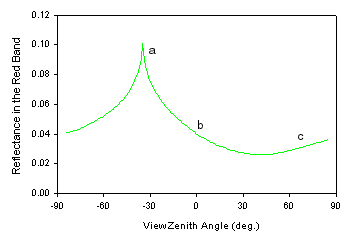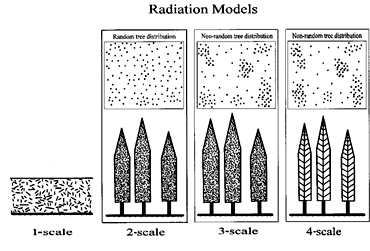A geometric-optical forest canopy model named "4-Scale" was
developed for LAI and FPAR
algorithm refinement and for parameterizing radiative transfer
sub-model in BEPS.
What is
a radiative transfer model?
A radiative transfer model simulates radiation transfer processes
in certain media, such as vegetation and atmosphere. For vegetation,
it computes the interaction between solar radiation and plants.
Solar radiation reflected from the Earth's surfaces and measured
by satellites depends strongly on the angles of the sun and
the satellite in relation to the surface. This bi-directional
behaviour is quantified using the Bi-directional
Reflectance Distribution Function (BRDF).
4-Scale is a radiative transfer model that simulates the
BRDF according to the structural properties of the vegetation.

Figure 1. BRDF rendering
of a forest canopy composed of opaque cone and cylindrical objects
viewed from 3 angles:
(a) backward scattering,
where the sun and the viewer are on the same side, hiding
most of the shadows;
(b) nadir view, where a maximum of the background can
be seen; and
(c) forward scattering where the sun and the viewer
are on the opposite side.

Figure 2. 4-Scale simulated reflectance from a forest canopy
at different view zenith angles on the plane parallel to the
sun with the corresponding cases from Figure 1.
Why our model is named "4-Scale"?
In forest canopies, the solar radiation is interacting with
the foliage at four different scales: within groups of trees,
within individual crowns, within branches, and within shoots.

Figure 3. Scales of plant canopy architecture considered in
reflectance models:
1-scale: turbid media;
2-scale: randomly distributed discrete objects containing
turbid media;
3-scale: non-random discrete objects containing turbid
media; and
4-scale: non-random discrete objects with internal
structures (such as branches and shoots).
4-Scale was developed with emphasis on the structural composition
of forest canopies at these scales and is a step forward from
existing 2-scale geometrical-optical models. It employs the
following modeling methodologies:
- The non-random spatial distribution of trees is simulated
using the Neyman type A distribution (Neyman, 1939) that
creates patches of a forest stand. The model simulates tree
crowns as discrete geometrical objects: cone and cylinder
for conifers, spheroid for deciduous species. The size of
the crowns decreases when the trees are found in large clusters,
and the tree locations are also subject to the repulsion
effects to better represent the competition for light.
- Inside the crowns, a branch architecture defined by a
single inclination angle is included to improve the calculation
of light penetration from the geometric-optical model of
Li and Strahler (1992) with the assumption of random leaf
distribution inside tree crowns. A branch is in turn composed
of foliage elements (individual leaves in deciduous and
shoots in conifer canopies) with a given angle distribution
pattern.
- The hotspot, where the view zenith and solar zenith angles
coincide, is computed both on the ground and for the foliage
with gap size distributions between and inside the crowns,
respectively.
- The crown is treated as a complex medium where shadowed
foliage can be observed on the sunlit side, and sunlit foliage
can be seen from the shaded side.
- A multiple scattering scheme, based on view factors, is
used to compute the amount of light reaching the shaded
foliage and background.
4-Scale has been validated with remote sensing data taken during
BOREAS
from the PARABOLA
and POLDER.
(Figure 4 and Figure 5)
4-Scale has been used to study the influence of different
canopy parameters on the retrieval of biophysical properties
with remotely sensed data (Leblanc et al 1997; Leblanc et
al 1999); to correct the BRDF effect of airborne data used
in the retrieval of leaf area index (Chen et al, 1998); and
to derive an improved BRDF correction for NOAA AVHRR data
(Chen and Cihlar, 1997).
4-Scale's code and a Microsoft Windows 95/98/NT version are
available on request from Jing Chen.

Screen shot of 4-Scale for Windows 95/98/NT.
References
Chen J.M. and J. Cihlar, 1997. "A hotspot function in
a simple bidirectional reflectance model for satellite applications."
Journal of Geophysical Research 102 (D22), pp. 25,907-25,913
Chen J.M. and S. G. Leblanc, 1997. "A Four-Scale Bidirectional
Reflectance Model Based on Canopy Architecture." IEEE
Transactions on Geoscience & Remote Sensing 35, pp. 1316-1337.
Chen J.M., S.G. Leblanc, J.R Miller, J. Freemantle, S.E.
Loechel, C.L. Walthall, K.A. Innanen, and H.P White. 1998
"Compact Airborne Spectrographic Imager (CASI) used for
Mapping Biophysical Parameters of Boreal Forests"
To appear in the second BOREAS special issue of Journal of
Geophysical Research-Atmosphere.
Leblanc, S. G., J. M. Chen and J. Cihlar, 1997. "NDVI
Directionality in Boreal Forests: A Model Interpretation of
Measurements". Canadian Journal of Remote Sensing 23,
pp. 368-379.
Leblanc S.G., P. Bicheron, J.M. Chen, M. Leroy and J. Cihlar,
1999. "Investigation of Directional Reflectance in Boreal
Forests with an Improved 4-Scale Model and Airborne POLDER
Data." IEEE Transactions on Geoscience & Remote
Sensing (in press)
Li, X. and A.H. Strahler, 1992. "Geometric-Optical Bidirectional
Reflectance Modeling of the Discrete Crown Vegetation Canopy:
Effect of Crown Shape and Mutual Shadowing.", IEEE Transactions
on Geoscience & Remote Sensing 30, pp. 276-292.
Neyman, J., 1939. "On a New Class of ¡®Contagious¡¯
Distribution Applicable in Entomology and Bacteriology",
Annals of Mathematical Statistics 10, pp. 35-57.
|